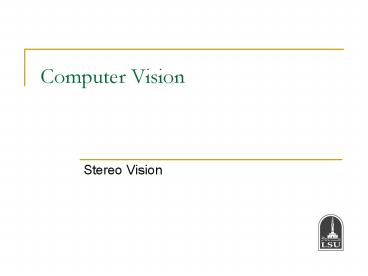Computer Vision PowerPoint PPT Presentation
Title: Computer Vision
1
Computer Vision
- Stereo Vision
2
Pinhole Camera
3
Perspective Projection
4
Stereo Vision
- Two cameras.
- Known camera positions.
- Recover depth.
scene point
p
p
image plane
optical center
5
Correspondences
p
p
6
Matrix form of cross product
aaxiayjazk
ababsin(?)u
bbxibyjbzk
7
The Essential Matrix
Essential matrix
8
Stereo Constraints
M
Image plane
Y1
p
O1
Z1
X1
Focal plane
9
A Simple Stereo System
LEFT CAMERA
RIGHT CAMERA
baseline
Right image target
Left image reference
Zw0
10
Stereo View
Right View
Left View
Disparity
11
Stereo Disparity
- The separation between two matching objects is
called the stereo disparity.
12
Parallel Cameras
P
Z
xl
xr
pl
f
pr
Ol
Or
Disparity
T
T is the stereo baseline
13
Finding Correspondences
14
Correlation Approach
LEFT IMAGE
- For Each point (xl, yl) in the left image, define
a window centered at the point
15
Correlation Approach
RIGHT IMAGE
(xl, yl)
- search its corresponding point within a search
region in the right image
16
Correlation Approach
RIGHT IMAGE
(xl, yl)
dx
(xr, yr)
- the disparity (dx, dy) is the displacement when
the correlation is maximum
17
Comparing Windows
18
Comparing Windows
Minimize
Sum of Squared Differences
Maximize
Cross correlation
19
Correspondence Difficulties
- Why is the correspondence problem difficult?
- Some points in each image will have no
corresponding points in the other image. - (1) the cameras might have different fields of
view. - (2) due to occlusion.
- A stereo system must be able to determine the
image parts that should not be matched.
20
Structured Light
- Structured lighting
- Feature-based methods are not applicable when the
objects have smooth surfaces (i.e., sparse
disparity maps make surface reconstruction
difficult). - Patterns of light are projected onto the surface
of objects, creating interesting points even in
regions which would be otherwise smooth.
- Finding and matching such points is simplified by
knowing the geometry of the projected patterns.
21
Stereo results
- Data from University of Tsukuba
Ground truth
Scene
(Seitz)
22
Results with window correlation
Estimated depth of field (a fixed-size window)
Ground truth
(Seitz)
23
Results with better method
A state of the art method Boykov et al., Fast
Approximate Energy Minimization via Graph Cuts,
International Conference on Computer Vision,
September 1999.
Ground truth
(Seitz)

